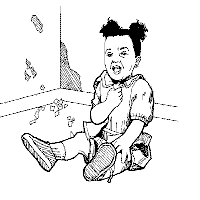| LEAD
POISONING SAFETY
 Lead poisoning is a common environmental health problem among children.
Even low blood lead levels can be harmful to children and have been associated
with decreased intelligence as a longterm complication. Most children
with elevated lead levels have no symptoms until they reach extreme levels.
The only way to tell they have lead poisoning is to test their blood.
Lead poisoning is a common environmental health problem among children.
Even low blood lead levels can be harmful to children and have been associated
with decreased intelligence as a longterm complication. Most children
with elevated lead levels have no symptoms until they reach extreme levels.
The only way to tell they have lead poisoning is to test their blood.
Young children,
especially those 18-24 months old, are at greatest risk for lead poisoning
because they often put their hands in their mouths and thus are more likely
to eat dust, paint, and soil contaminated with lead. Children also absorb
lead more easily. Because of their growth, development, and increased
metabolism (the process the body uses to change nutrients to energy),
children are more sensitive to the harmful health effects of lead.
Children
can be exposed to lead by:
- Eating
lead-based paint chips or dust or soil contaminated with lead-based
paint or leaded gasoline. Most children get lead poisoning from breathing
in lead-based paint dust or chewing on surfaces, such as windowsills
or other surfaces close to the floor, that have been painted with lead-based
paint. This usually happens in older homes, and especially those that
are being or have recently been remodeled.
- Drinking
water that has moved through lead pipes.
- Being
exposed to lead dust carried by family workers who work with lead.
- Eating
food served on lead-glazed pottery or improperly fired ceramic ware.
- Eating
food taken from lead-soldered cans.
- Taking
some traditional medicines that contain lead, such as greta or azarcon.
- Being
exposed to lead through contamination of the environment by adult hobbies,
such as making stained glass or pottery.
As a child
care provider, you can help reduce children's risk of lead poisoning by:
- Washing
children's hands frequently and before meals.
- Feeding
children diets rich in iron and calcium, which will reduce the amount
of lead absorbed from the gastrointestinal tract.
- Preparing
and storing food in containers that do not release lead, such as those
made of glass, stainless steel, or plastic. Never store food in opened
cans. Only use ceramic containers that have labels saying they are made
with lead-free glazes .
- Only using
toys and arts and crafts materials that do not contain lead. Arts and
crafts materials made after 1990 that are labeled "conforms to
ASTM D-4236" and that have no health warnings are considered nontoxic.
- Relocating
during remodeling projects that may create lead-based-paint dust.
- Having
your facility evaluated for lead hazards if you believe it may be at
risk. Older buildings with deteriorating paint carry a greater risk
for lead hazards, as do buildings thought to have been a source of lead
exposure for a child who has been diagnosed with lead poisoning. Lead
paint concentrations were highest before 1950, but lead continued to
be used in residential paint until 1978.
- To get
further information on testing for lead and on preventing lead poisoning,
call your state or local health department, the National Lead Information
Hotline, (800) LEAD-FYI, or the National Lead Information Clearinghouse,
(800) 424-LEAD.
|